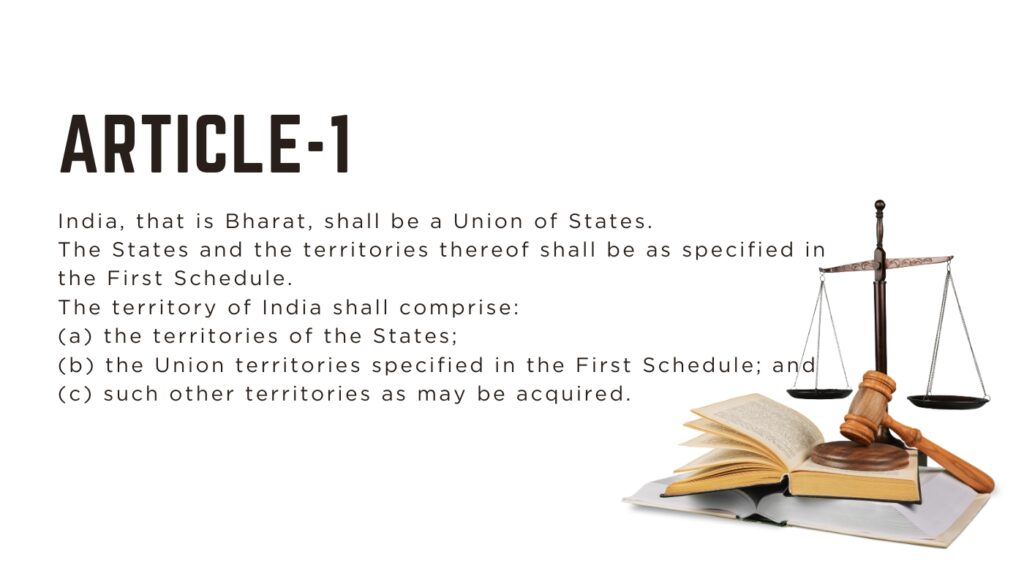Article 1 of Constitution is often perceived as a mere formal statement defining the name and structure of the country. However, it is far more significant—it serves as the cornerstone of India’s identity, sovereignty, and territorial unity. By declaring “India, that is Bharat” as a Union of States, Article 1 encapsulates the essence of India’s federal structure and its indivisible nature.
Let’s dwell into the text, meaning, historical context, judicial interpretations, and contemporary relevance of Article 1 to highlight its profound importance in India’s constitutional framework.

Table of Contents
Text of Article 1 of Constitution
The full text of Article 1 reads:
- India, that is Bharat, shall be a Union of States.
- The States and the territories thereof shall be as specified in the First Schedule.
- The territory of India shall comprise:
(a) the territories of the States;
(b) the Union territories specified in the First Schedule; and
(c) such other territories as may be acquired.

Article 1: Key Concepts
“India, That Is Bharat” – A Dual Identity
The phrase “India, that is Bharat” reflects India’s dual nomenclature—a blend of ancient heritage and modern nationhood. While Bharat connects us to our civilizational roots, India aligns with global diplomacy and international law.
Constituent Assembly Debates:
During discussions, members debated whether India should be called Bharat, Hindustan, or something else. The final decision to retain both names was a compromise to honor cultural heritage while ensuring international recognition.
“Union of States” – Indivisibility Over Federalism
India’s designation as a “Union of States” signifies that it is not a federation in the traditional sense (like the USA). States do not have the right to secede, and their existence and boundaries are subject to Parliament’s authority under Article 3.
Implications:
- Ensures national unity in a diverse country with linguistic, cultural, and regional variations.
- Reinforces that states derive their powers from the Constitution rather than pre-existing agreements.
Reference to the First Schedule
The First Schedule lists all states and union territories along with their boundaries. It provides a dynamic framework for India’s political geography, allowing changes through parliamentary legislation.
Example:
The Jammu & Kashmir Reorganization Act (2019), which reorganized J&K into two Union Territories—Jammu & Kashmir and Ladakh—was implemented by modifying the First Schedule.
Clause 3(c): Acquisition of New Territories
Article 1 empowers India to acquire new territories through treaties or other constitutional means. This provision has been used historically to integrate regions like Goa (1961) and Sikkim (1975).
Historical Context: Constituent Assembly Debates
Dr. B.R. Ambedkar emphasized that calling India a “Union” was intentional to prevent separatist tendencies and ensure indivisibility. He stated:
“The Indian Federation is a Union because it is indestructible.”
This decision reinforced India’s commitment to unity amidst diversity.
Judicial Interpretations
Berubari Union Case (1960): Territorial Cession
The Supreme Court ruled that ceding Indian territory requires a constitutional amendment rather than an executive order under Article 1 of Constitution.
SR Bommai v. Union of India (1994): Federalism and Unity
The court reaffirmed that India’s unity is inviolable under Article 1 of Constitution, emphasizing its role in maintaining national integrity.
Territorial Evolution Under Article 1
| Year | Territorial Change | Legal Basis |
|---|---|---|
| 1956 | States Reorganization Act | Article 3 + First Schedule |
| 1961 | Goa’s Integration | Clause 3(c) |
| 1975 | Sikkim as State | Constitutional Amendment |
| 2019 | J&K Reorganization | Article 3 + Presidential Order |
Why Article 1 of Constitution Matters Today
- Centre-State Relations: Amid rising federal disputes, Article 1 reinforces India’s constitutional unity.
- Naming Debates: Renewed discussions on using “Bharat” more prominently reflect its enduring relevance.
- International Recognition: Defines India’s identity under treaties and global frameworks.
- Territorial Integrity: Strengthens India’s claims in cross-border disputes with neighboring countries like China or Pakistan.
FAQs on Article 1 of Constitution
Q1: Can states secede from India under Article 1?
No. India is a Union of States where secession is constitutionally prohibited.
Q2: Can “India” be renamed solely as “Bharat”?
A constitutional amendment would be required since both names are official under Article 1.
Q3: Does India still have the power to acquire new territories?
Yes, Clause 3(c) allows acquisition through treaties or other legal means.
Q4: What does the First Schedule signify?
It lists all states and union territories along with their boundaries.
The Bedrock of India’s Identity
Article 1 of Constitution of India establishes India’s name (India, that is Bharat), territorial composition, and federal structure in one concise provision. It embodies India’s unity amidst diversity while asserting its sovereignty on the global stage.
Understanding Article 1 of Constitution is essential for grasping India’s constitutional philosophy—it lays the foundation for how India sees itself as an indivisible nation bound by shared values and aspirations. Whether in legal debates or geopolitical discussions, this article remains central to India’s identity as a modern republic rooted in ancient heritage.
For more Article Explained Please Check out our Bare acts Explained Section, from our Home Page.
[…] federal structure by dividing powers between the central government and the states, as detailed in Articles 1, 246, and the Seventh Schedule, while also incorporating unitary features to maintain national […]